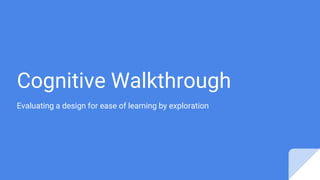Cognitive Walkthrough
- 1. Cognitive Walkthrough Evaluating a design for ease of learning by exploration
- 2. What is CW Usability inspection method Focused on ease of learning, by exploration
- 3. Description of the Walkthrough Process Evaluate an interface in the context of specific tasks Interface design (Paper mock-up, Prototype) Task Scenario Explicit Assumptions (user population, context of use) Sequence of actions a user should perform
- 4. Scope and Limitations of Method Focus on just one method of usability, ease of learning Would push design trade-offs in an interface in the direction of ease of learning The method finds: Mismatches Poor choices Inadequate feedback
- 5. The Walkthrough Phases The cognitive walkthrough analysis has two phases: A preparatory phase The tasks Action sequences for each task User population The interface that will be subjected to analysis Analysis phase
- 6. Individual or Group process The designer presents the design to a group of peers. Other designers Software engineers Marketing Documentation QA
- 7. Defining the Inputs to the Walkthrough Before the walkthrough analysis begins, four areas must be agreed upon Who will be the users of the system? What task (or tasks) will be analyzed? What is the correct action sequence for each task and how is it described? How is the interface defined?
- 8. Walking Through the Actions The analysis phase of the walkthrough Tell a credible story as to why the expected users would choose that action Credible stories are: Based on assumptions about the user's background knowledge and goals On an understanding of the problem-solving process
- 9. The problem-solving process Described by Polson and Lewis' CE theory of exploratory learning 1. Start with a rough description of the task they want to accomplish 2. Explore the interface and select actions they think will accomplish the task 3. Observe the interface reactions to see if their actions had the desired effect 4. Determine what action to take next
- 10. The problem-solving process 1. Will the users try to achieve the right effect? 2. Will the user notice that the correct action is available? 3. Will the user associate the correct action with the effect trying to be achieved? 4. If the correct action is performed, will the user see that progress is being made toward solution of the task?











